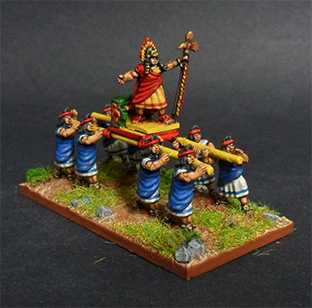15mm Historical Ranges
Sci Fi, Pulp and Fantasy Ranges
Home
Ordering
Blog
15mm Inca
 The Inca Emperor on palanquin |
This range represents the armies of the Inca Empire, the greatest pre-Columbian power in South America, and by some measures the greatest of all pre-Columbian powers. Inca armies were organized around regular units which wore uniforms, with even such small details as headwear being rigorously enforced. The death penalty could be the punishment for anyone not wearing the correct hat! Elite Inca regiments had to pass an extraordinary survival course before joining the ranks, including training in a variety of weapons use. The national weapon of the Inca was the sling, a barrage of stones from which was apparently an experience that had to be experienced to be appreciated. However, some Inca troops are also shown in period art as advancing in close order with spears, and some elites are shown using a polearm strangely similar to the European Halberd, so the Inca were capable close combat opponents as well. The core of the empire was the Quechua people of the Andes mountains, who provided the bulk of troops. The empire continuously expanded and absorbed other peoples, who were conscripted en masse into the army upon conquest (often to keep them from rebelling), and these wore their native garb, although it is thought that the Inca may have made some changes to this or to the conquered peoples' equipment. Inca commanders rode on platforms, and the Inca's platform was carried by a special order of men. Vast numbers of porters carried the provisions of an army in sacks over their shoulders or on llamas. The only peoples to have stopped the Inca in their conquests were the mighty Mapuche -- and even musket armed Spanish regulars in the eighteenth century had trouble with them! (We make a range of the fully developed Mapuche army of the seventeenth century -- see the listings.) The early and seemingly simple initial consolidation of the Spanish invasion was due to their fortuitous arrival at the nadir of Inca fortune -- when plague had obliterated the population and in the midst of a civil war between rival imperial brothers. Once the Inca were able to consolidate their resistance to the Spanish invaders they were able to establish a rump state that resisted for decades, although it was too late to turn the tide, and the Spanish overthrew the rump state in 1572. |
| Code | Contents | Price (US$) | Order/Progress |
|---|---|---|---|
| INCA-PALANQUIN | Inca high commander on palanquin with eight bearers | $8.99 | |
| INCA-ELITE-YAURI | Elite Inca warriors with tupa yauri "halberd" (x6 in three poses) | $4.49 | |
| INCA-ELITE-SPEAR | Elite Inca warriors with spear (x12 in four poses) | $8.99 | |
| INCA-VETERANS | Veteran Inca warriors with spear (x12 in four poses) | $8.99 | |
| INCA-LEVY-SPEARS | Inca Quechua levies with spear (x12 in four poses) | $8.99 | |
| INCA-LEVY-SLING | Inca Quechua levies with sling (x12 in four poses) | $8.99 | |
| INCA-AMAZONIANS | Inca Amazonian subject archers (x8 in four poses, with separate hardwood clubs) | $5.99 | |
| INCA-CANARI | Inca Canari subjects with long spear (x12 in four poses) | $8.99 | Coming soon! |
| INCA-PORTERS | Inca male and female porters and llama (x6 in three poses) | $4.49 |
